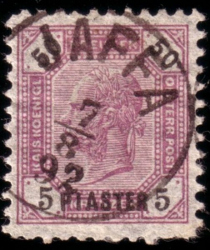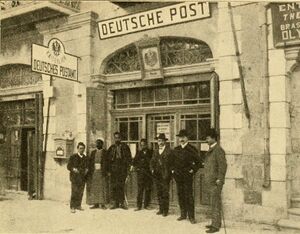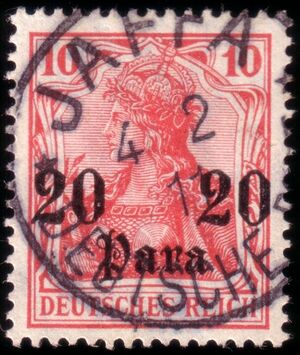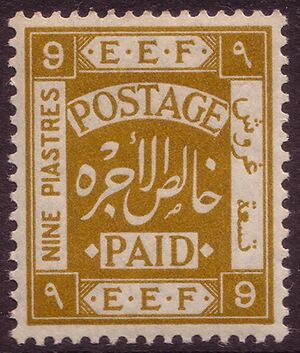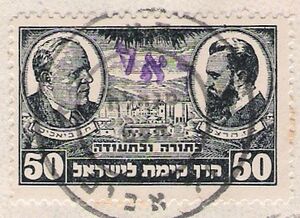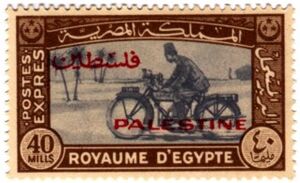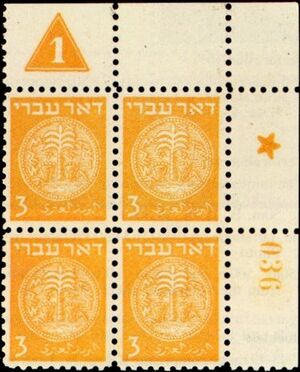الطوابع والتاريخ البريدي لفلسطين
ظهرت الطوابع البريدية والتاريخ البريدي لفلسطين من موقعها الجغرافي كمفترق طرق بين إمبراطوريات الشرق الأدنى القديم وبلاد الشام والشرق الأوسط. تأسست الخدمات البريدية في المنطقة لأول مرة في العصر البرونزي، خلال حكم سرگون من أكاد، وأنشأت الإمبراطوريات المتعاقبة وتم تشغيل عدد من الأنظمة البريدية المختلفة على مدى آلاف السنين.
في عصر البريد الحديث ، تضمنت الإدارة البريدية في فلسطين مكاتب بريد نمساوية و فرنسية و إيطالية و ألمانية ومصرية وروسية و(من خلال الترتيبات التي تم إجراؤها مع الدولة العثمانية)، وقوات المشاة المصرية، و الانتداب البريطاني، ومختلف السلطات المؤقتة في الفترة التي تسبق الحرب العربية الإسرائيلية عام 1948 وبعدها. منذ عام 1948 ، تم توفير الخدمات البريدية من قبل مصر والأردن وإسرائيل والسلطة الوطنية الفلسطينية.
عند مناقشة التاريخ البريدي قبل عام 1948، يشير معظم هواة جمع الطوابع إلى هذه المنطقة الجغرافية على أنها فلسطين أو الأراضي المقدسة، على الرغم من أن البعض يستخدم أرض إسرائيل . يستعرض هذا المقال التاريخ البريدي المؤدي إلى الإدارتين البريديتين الحاليتين في المنطقة، وهما إدارة دولة إسرائيل والسلطة الوطنية الفلسطينية.
الخلفية
العصور القديمة الكلاسيكية
قبل التاريخ البريدي الحديث ، وضعت الإدارات الإمبراطورية آليات لتسليم الطرود والرسائل.
يُعتقد أن أقدم استخدام لنظام بريدي في المنطقة يعود إلى العصر البرونزي، أثناء حكم سرگون من أكاد (2333-2279 قبل الميلاد). كانت إمبراطوريته، مرتبطة ببعضها البعض من خلال الطرق، حيث كانت هناك خدمة بريدية منتظمة، وأختام الطين التي أخذت مكان الطوابع الآن في متحف اللوفر تحمل أسماء سرگون وابنه.[1]
خلال الحكم الفارسي (538-333 قبل الميلاد)، شكلت شبكة واسعة من الطرق التي كانت تحتفظ بها الحكومة الفارسية جزءًا من نظام بريدي إمبراطوري فعال. يعود الفضل في إنشاء النظام البريدي والتحسينات التي أدخلت على شبكة الطرق إلى الملك داريوش الأول (521-486 قبل الميلاد). [2] كان حاملو الخيول ، المعروفون باسم "الرسل السريع" (باللغة الفارسية: pirradaziš) ، ينقلون المراسلات بين البلاط الملكي والمحافظات، ويتوقفون فقط لتناول الطعام والراحة، وتغيير الخيول حسب الحاجة، في محطات الإمداد التي تقع على مسافة قريبة من السفر ليوم واحد.[3] يشكل نظام البريد السريع الفارسي جزءًا من الخلفية للأحداث الموصوفة في سفر أستير الكتاب المقدس العبري.[4]
الخلفاء العرب (628-1099)
كما طورت الدولة الأموية (661-750) التي أدخلت "أول عملة عربية بحتة" في فلسطين أيضًا نظامًا للخدمات البريدية.[5] تم توزيع الخانات على طول الطرق الرئيسية بين الشمال والجنوب والشرق والغرب التي كانت بمثابة أماكن استراحة للحجاج والمسافرين ، مما سهل تشغيل الخدمة البريدية المعروفة باسم البريد.[6] النظام البريدي المعروف باسم Bar knownd (العربية: بريد) كان يعمل أيضًا في ظل حكم الخلافة العباسية (750-969)، ولا تزال الكلمة تستخدم اليوم للإشارة إلى "البريد" في جميع أنحاء العالم العربي.[7][8] في ظل الحكم الفاطمي (969-1099) ، تم الحفاظ على عمود الحمام الذي أتقنه المماليك فيما بعد. تم حفظ نسب الحمام الزاجل في مسجل خاص.[9]
الفترة الصليبية (1099-1187)
وثق مؤرخو الحملة الصليبية الأولى فرصة اعتراض رسالة تحذر دوق قيصرية من قدوم الجيوش الصليبية عندما سقط الحمام الزاجل من قبل صقر فوق معسكر صليبي عسكري في مايو 1099. نصت الرسالة المكتوبة بـ العربية على النحو التالي:
تحيات من ملك عكا إلى دوق قيصرية. لقد مر جيل من الكلاب ، عرق أحمق ، عنيد ، وغير منظم ، عبر أرضي. إذا كنت تقدر أسلوب حياتك ، فيجب عليك أنت والآخرين من المؤمنين إلحاق الأذى بهم ، حيث يمكنك بسهولة فعل ما يحلو لك. أنقل هذه الرسالة إلى مدن ومعاقل أخرى.[10]
تم استخدام الحمام الزاجل بانتظام في هذه الفترة. على سبيل المثال ، يشير إدوارد جيبون إلى أنه أثناء حصار الصليبيين لعكا (1189-1191) ، كان سكان المدينة المحاصرة يحتفظون بمراسلات منتظمة مع قوات السلطان عن طريق الحمام الزاجل.[11]
حكم المماليك (1270-1516)
أثناء حكم المماليك، تم تشغيل خدمة بريد ركاب في دير البلح و اللد ولجون ومدن أخرى علي طريق القاهرة الي دمشق.[12] النظام البريدي الذي أنشأه المماليك بقيادة بيبرس عرف باسم "البارود" كما كان في عهد الخلافة العربية. وأرجع ابن شقيق السكرتير العام للسلطان بيبرس تبني "بريد" وتطوره من قبل المماليك إلى توصيات عمه الصاحب شرف الدين أبو محمد الوهاب. يسجل ابن الأخ أنه استجابة لطلب من بيبرس بأن يظل على اطلاع دائم بآخر التطورات المتعلقة بـ الفرنجة و المغول الوهاب، "أوضح له أن حقق "بارود" في العصور القديمة والخلافة واقترح عليه [هذا النظام] ؛ وقد أحب [السلطان] الفكرة وأمر [بتأسيسها] ".[8]
بعد أن طرد المماليك الصليبيين ، وضموا الإمارات الأيوبية وهزموا الجيش المغولي في الأناضول، أنشأ بيبرس ولاية سوريا (التي شملت فلسطين)، وعاصمتها دمشق. في هذه المرحلة، كانت الاتصالات الإمبراطورية في جميع أنحاء فلسطين فعالة للغاية لدرجة أن بيبرس كان يتباهى بأنه يمكن أن يلعب بولو في القاهرة ودمشق في نفس الأسبوع. تم الحفاظ على مركز للحمام الزاجل أسرع بين المدينتين.[13] وقد لوحظ استخدامه في تشكيل تحالف دفاعي ضد الصليبيين من قبل ريموند من أجيليز ، الذي اعتقد أنه "غير رياضي".[14]
الحكم العثماني (1516-1918)
الخدمات البريدية في العهد العثماني
خلال الحكم العثماني في فلسطين ، كانت الطوابع الصادرة عن السلطات العثمانية سارية في فلسطين.[15] في عام 1834 ، بعد تحسين أنظمة النقل والاتصالات ، أنشأ العثمانيون نظامًا بريديًا إمبراطوريًا جديدًا. كانت مكاتب البريد العثمانية تعمل في كل مدينة كبيرة في فلسطين تقريبًا ، بما في ذلك عكا ، حيفا ، صفد ، طبريا ، نابلس ، القدس و يافا و غزة.[16] بفضل عمل علماء الطوابع ، من الممكن إعادة بناء قائمة موثوقة من مكاتب البريد العثمانية في فلسطين.
أدى المرسوم الإمبراطوري الصادر في 12 راماسان 1256 (14 أكتوبر 1840)[17] إلى تحسينات جوهرية في النظام البريدي العثماني وتم إنشاء شبكة من طرق الإرسال المنتظمة (التتار).[18] وابتداءً من عام 1841 ، تم تمديد طريق بيروت ليخدم فلسطين ، من بيروت عبر دمشق وعكا إلى القدس.[19]
تم تنظيم الخدمات البريدية على المستوى المحلي من قبل حكام المقاطعات وتم طرح هذه الإيجارات (posta mültesimi) للمزاد سنويًا في شهر مارس.[18] يُذكر أنه في عام 1846، أصبح رجال لأعمال الإيطاليون سانتيلي وميكسياريلي مستأجرين ويديرون خدمة من القدس إلى الرملة، يافا و صور و صيدا.[20] بحلول عام 1852 ، تم تشغيل خدمة أسبوعية من صيدا عبر صور وعكا (اتصال ببيروت) وحيفا ويافا إلى القدس ، وهي تخدم أيضًا نابلس ابتداءً من عام 1856. وفي نفس العام ، بدأ تشغيل طريقين جديدين: القدس - الخليل - غزة وطبريا - الناصرة - الشفا - عمرو - عكا.[21] في عام 1867 ، كان طريق القدس - يافا يعمل مرتين في الأسبوع ، وبدءًا من عام 1884 ، كان طريق نابلس - يافا يتلقى إرساليات يومية.[21]
في القرن الماضي من الحكم العثماني، بالإضافة إلى خدمة بريد الدولة العثمانية ، سُمح أيضًا لما يصل إلى ست قوى أجنبية بتشغيل الخدمات البريدية على الأراضي العثمانية، مع هذه الحقوق الناشئة عن تعهدات الدولة العثمانية والمعاهدات الثنائية الأخرى.[22] في بداية الحرب العالمية الأولى ، ألغت السلطات العثمانية الحقوق البريدية المحددة التي تتمتع بها هذه القوى الأجنبية في جميع أنحاء الإمبراطورية. ابتداءً من عام 1900 وحتى نهاية الحرب ، مُنع المواطنون العثمانيون ، بمن فيهم أولئك الموجودون في فلسطين ، من استخدام خدمات مكاتب البريد الأجنبية.[22][23]
يصف جوزياس ليزلي بورتر في كتابه دليل للمسافرين في سوريا وفلسطين (1858) النظام الذي تديره السلطات العثمانية في ذلك الوقت:
"مكتب البريد" في سوريا ما زال في مهده. هناك رسائل أسبوعية بين القدس و بيروت ، تقطع المسافة في حوالي أربعة أيام ، وهناك بريد نصف أسبوع بين دمشق وبيروت ، يستغرق حوالي 22 ساعة في الطقس الجيد ، ولكن أحيانًا أسبوعين في الشتاء ؛ وهناك تارتار أسبوعي[24] من دمشق إلى حمص و حماه وحلب والقسطنطينية - مما جعل المسافة كاملة في 12 يومًا. يغادر يوم الأربعاء. يجب توجيه جميع الرسائل بهذه الطرق باللغة العربية أو التركية والدفع المسبق. المشاركات التركية ليس لها صلة بتلك الموجودة في أي دولة أخرى ؛ وبالتالي ، يجب إرسال الرسائل الخاصة بالدول الأجنبية إما عن طريق القنصل ، أو من خلال وكلاء البريد لتلك البلدان ، المقيمين في الموانئ البحرية ".[25]
مكاتب البريد العثمانية
في البداية ، كانت جميع المرافق البريدية في وضع محطات الترحيل ، وكانت الرسائل تتسلم علاماتها البريدية فقط في مكتب بريد بيروت ، باستثناء واحد: يُعتقد أن علامات " جبل لبنان"[26] قد تم تطبيقها في محطة الترحيل ستورا (لبنان). في ستينيات القرن التاسع عشر، تمت ترقية معظم محطات الترحيل إلى حالة مكاتب البريد الفرعية واستلمت علامات بريدية ، كانت في البداية أختامًا سلبية فقط.[27] احتوت العلامات البريدية للقسم البريدي للمكتب عادةً على الكلمات posta shubesi، بدلاً من telegraf hanei لقسم التلغراف. في عام 1860، تم تشغيل عشرة منشآت بريدية في فلسطين، وارتفعت إلى 20 في عام 1900 و 32 في عام 1917. وكانت مكاتب البريد المتنقلة موجودة على ثلاث طرق: "يافا - القدس"،[23] و دمشق - حيفا، ومسودشي - نابلس.[28][29] لا توجد علامات بريد TPO معروفة لخطوط السكك الحديدية الأخرى.[30]
أسعار البريد العثماني (1840-1918)
يميز المرسوم الإمبراطوري الصادر في 12 راماسان 1256[17] والمراسيم اللاحقة بين ثلاثة أنواع من عناصر البريد: الحروف العادية، والحروف المسجلة (علامات تهود أولونموشدور)، والرسائل الرسمية (علامات الطاهر موهوم).[31] تم حساب الرسوم حسب نوع البريد والوزن والمسافة (تقاس بالساعات): في عام 1840 ، كانت تكلفة الحرف العادي ، التي يقل وزنها عن 10 جرام ، في الساعة 1 فقرة.[32][33] الرسوم الخاصة المطبقة على العينات والبريد المؤمن عليه والتسليم الخاص والمطبوعات وما إلى ذلك.[32] تغيرت هذه الأسعار البريدية بشكل متكرر ، وأضيفت خدمات جديدة على مر السنين. عند الانضمام إلى الاتحاد البريدي العالمي في 1 يوليو 1875 ، كانت الأسعار العثمانية في الخارج متوافقة مع قواعد الاتحاد البريدي العالمي.
مكاتب البريد الأجنبية

حصلت النمسا و فرنسا على تصاريح لتقديم خدمات بريدية في المدن الرئيسية للإمبراطورية العثمانية منذ عام 1837. في عام 1852 ، افتتح البلدان مكاتب بريد خارجية في المدن الرئيسية في فلسطين. حذت دول أوروبية أخرى حذوها: روسيا عام 1856 ، ألمانيا عام 1898 ، وإيطاليا عام 1908. سهلت مكاتب البريد الأجنبية هذه الاتصالات العائلية والاجتماعية وتحويل الأموال من أوروبا إلى الأراضي المقدسة.[16]
مكاتب البريد الروسية
في أوائل القرن التاسع عشر ، أنشأ الروس طرقًا ملاحية في شرق البحر الأبيض المتوسط وقدموا خدمة بريدية. بدأت الخدمة البريدية الروسية في الإمبراطورية العثمانية في عام 1856 تديرها الشركة الروسية للتجارة والملاحة (Russkoe Obschestvo Parokhodstva i Torgovli أو ROPiT). تعاملت ROPiT مع خدمة البريد بين مختلف المكاتب ، وأرسلت البريد إلى روسيا عبر أودسا وحصلت مكاتبها على وضع مكافئ لمكاتب البريد الروسية العادية في 1863. كانت وكالات الشحن والبريد التابعة لـ ROPiT موجودة في عكا (1868-1873) ، حيفا (1859-1860 ، 1906-1914) ، يافا (1857-1914) والقدس (1901-1914).[34][35]
مكاتب البريد النمساوية
The Austrian Empire established a mail system in the Mediterranean through the shipping company Österreichischer Lloyd. Lloyd postal agencies operated in Jaffa (1854), Haifa (1854), and Jerusalem (1852).[36][37] These three offices later became the Austrian Imperial and Royal Post Offices: Jerusalem (March 1859), Jaffa and Haifa (1 February 1858).[38] Collecting or forwarding agencies existed in Mea Shearim (Jerusalem), Safed, and Tiberias.[39][40] Safed and Tiberias were served by a private courier via the local Austrian consular agent.[41] Nazareth and Bethlehem were never served by the Austrians. Postal service to Jerusalem was arranged privately.[42]
In a number of Jewish settlements, local traders or officials served as auxiliary collection and deposit agents: Gedera, Hadera, Be'er Tuvia, Petah Tikva, Rehovot, Rishon Le Zion, Yavne'el, and Zikhron Ya'akov.[40][43][44] By special arrangement, as an inducement to use the Austrian service for foreign mail as well, the Austrian post transported letters and cards between these Jewish settlements free of charge.[45] The use of local or JNF labels on such postal matter was not necessary.[46]
The stamps used were Austrian stamps for Lombardy-Venetia and, after 1867, Austrian Levant stamps, as pictured here.[47]
مكاتب البريد الفرنسية
The French operated a number of post offices in the Ottoman Empire, often in conjunction with the local French consulates. In Palestine, three offices were opened: Jaffa (1852), Jerusalem (1890) and Haifa (1906).[48][49] The stamps used were regular French ones, after 1885 stamps overprinted in Turkish currency, and from 1902 also French Levant stamps.[49] Of the French postal arrangement, Porter describes it as "quick and safe, though frequently altered."[25] French mail-steamers, known as the Messagerie Imperiale ("Postal Line"),[50] operated by the Compagnie des Services Maritimes des Messageries Nationales,[51] departed every fortnight from the coast of Syria to Alexandria and Constantinople. From the ports at Alexandretta, Latikia, Tripoli, Beirut, and Yâfa, letters could be posted to Italy, France, England or America.[25]
مكاتب البريد الألمانية
The German Empire opened its first office on October 1, 1898, in Jaffa, followed on March 1, 1900, by an office in Jerusalem.[52][53] Both offices closed in September 1914. Auxiliary collecting agencies existed in Ramleh (1902), Rishon LeTzion (1905), Wilhelma Hamidije (1905), Sarona (1910), Emmaus (1909), Sebil Abu Nebbut (1902, a quarantine station at the Jaffa city boundary), and Jerusalem's Jaffa Gate.[54] Mail collecting points were also present in Beit Jala, Bethlehem, Hebron, and Ramallah.[55] Regular German stamps, and stamps overprinted in Turkish currency,[56] and French currency[57] were in use.[58] Stamps were only cancelled at the three post offices, mail from the agencies received boxed cachets.[59]
مكاتب البريد الإيطالية
افتتح مكتب البريد الإيطالي في القدس في 1 يونيو 1908. تم إغلاقه مؤقتًا بين 1 أكتوبر 1911 و 30 نوفمبر 1912 ، واستمر العمل حتى 30 سبتمبر 1914.[60][61]كانت الطوابع المستخدمة هي الطوابع الإيطالية العادية (غير المطبوعة) ، والطوابع المطبوعة بالعملة التركية ، والطوابع المطبوعة فوق القدس.[62][63][64]
مكاتب البريد المصرية
تم تشغيل مكتب بريد مصر في يافا بين يوليو 1870 وفبراير 1872.[65] الختم البريدي يقرأ V.R. Poste Egiziane Iaffa.[66] كما يوجد ختم interpostal ليافا.[67][68][69]
خدمات بريدية أخرى
يمكن للمسافرين الإنجليز في المنطقة تلقي بريد من الخارج إذا كان موجهًا إلى رعاية القناصل الإنجليز في بيروت أو حلب أو القدس أو دمشق ، أو بدلاً من ذلك إلى رعاية تاجر أو مصرفي.[25]
British E.E.F. stamps and service (1917–1920)
In November 1917, the British Egyptian Expeditionary Force occupied Palestine.[70][71] Initially, the Egyptian Expeditionary Force (and the Indian Expeditionary Force) had given civilians basic postal services for free, with additional services paid in British or Indian stamps.[70] Free mail was withdrawn with the printing of appropriate stamps.[72][73] Two stamps inscribed E.E.F. (1 Piastre, and 5 Millièmes) were issued in February 1918,[74][75] the first definitives (11 values) were circulated from June 1918.[76][77] These E.E.F. stamps were valid in Palestine, Cilicia,[78] Syria, Lebanon, and Transjordan.[79] Prior to the British Mandate in Palestine, Hebrew was not an official language, and so these stamps bore only Arabic inscriptions besides English.[80]
الانتداب البريطاني (1920–1948)
In 1920, Transjordan was separated and distinctive overprints for the two territories came into use.[81][82] As Palestine came under the civil administration of the British Mandate of Palestine[1],[81] falling into line with League of Nations rules, the High Commissioner sanctioned stamps (as pictured here) and coins bearing the three official languages of British Mandate Palestine: English, Arab, and Hebrew.[83] Between 1920 and 1923 six such distinctive overprints were issued: four produced in Jerusalem, two in London.[بحاجة لمصدر]
Local Jews and Arabs lobbied the British about the overprint (pictured):[84]
The Jewish members of the [Advisory] Council objected to the Hebrew transliteration of the word "Palestine", on the ground that the traditional name was "Eretz Yisrael", but the Arab members would not agree to this designation, which, in their view, had political significance. The High Commissioner therefore decided, as a compromise, that the Hebrew transliteration should be used, followed always by the two initial letters of "Eretz Yisrael", Aleph Yod, and this combination was always used on the coinage and stamps of Palestine and in all references in official documents.
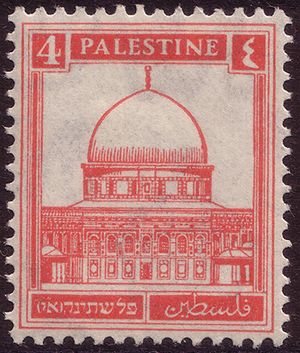
During the Mandate, postal services were provided by British authorities. The British Post service designed its first four stamps in 1923, upon the suggestion of the Sir Herbert Samuel (the High Commissioner), following a public invitation for designs.[85] The first values in this series of definitive stamps were issued on June 1, 1927.[86] The stamps pictured the Rachel's Tomb, the Tower of David, the Dome of the Rock, and a view of a mosque in Tiberias and the Sea of Galilee. According to Reid, the British Mandate "scenes carefully balanced sites of significance to Muslims, Jews, and Christians."[87]
The postal service operated by the Mandatory authorities was reputed to be the best in the Middle East. Letters were delivered daily in Jerusalem. Palestine joined the Universal Postal Union in October 1923.[88] The post was transported by boat, train, cars and horses, and after 1927, also by air.[89] Sale and exchange of international reply coupons started in 1926[90] and were joined by Imperial Reply Coupons from January 1, 1935.[91] Air letter sheets (or air letter cards as they were then known) were first introduced in Palestine in November 1944.[92][93] During the volatility of 1947 and 1948, British postal services deteriorated and were replaced by ad hoc interim services prior to the partition and the establishment of the State of Israel.[بحاجة لمصدر] Just before the formal end to the British Mandate over Palestine, the Mandatory government destroyed the existing stocks of postage stamps and had Palestine removed from the World Postal Union.[94] A total of 104 stamps bearing the name "Palestine" were issued by the British between 1918 and 1942.[15]
مكاتب بريد الانتداب
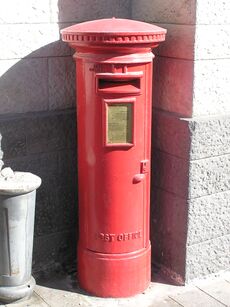
خلال فترة الانتداب البريطاني على فلسطين ، كان يعمل حوالي 160 مكتبًا بريديًا ووكالة ريفية ومكاتب بريد متنقلة ووكالات بلدات ، بعضها لبضعة أشهر فقط ، والبعض الآخر طوال الفترة بأكملها. عند تقدم قوات الحلفاء في عامي 1917 و 1918 ، خدمت مكاتب البريد الميدانية ومكاتب بريد الجيش السكان المدنيين المحليين في البداية. تم تحويل بعض المكاتب الأخيرة إلى مكاتب بريد ثابتة للجيش وأصبحت مكاتب بريد مدنية عند إنشاء الإدارة المدنية. في عام 1919 ، كان يوجد خمسة عشر مكتبًا ، وارتفع العدد إلى حوالي 100 بحلول عام 1939 ، وحوالي 150 بحلول نهاية الانتداب في مايو 1948. مع تدمير معظم أرشيفات مكتب البريد العام في القدس ، تعتمد الأبحاث بشكل كبير على هواة جمع الطوابع الذين يسجلون علامات بريدية مميزة وتواريخ استخدامهم.
معدلات الانتداب البريدية
بعد احتلال قوات التحالف عام 1917 ، أصبحت الطوابع البريدية الأساسية مجانية للمدنيين. كان لابد من تحرير رسوم التسجيل والطرود باستخدام الطوابع البريطانية أو الهندية. بمجرد طرح طوابع EEF المطبوعة في القاهرة للبيع ، كان لا بد من دفع ثمن البريد إلى الوجهات الخارجية اعتبارًا من 10 فبراير 1918 ، ومن 16 فبراير 1918 أيضًا بالبريد إلى الأراضي المحتلة في ذلك الوقت ومصر.
يتبع هيكل الأسعار البريدية الممارسة البريطانية على نطاق واسع ، وأضيفت خدمات جديدة ، مثل البريد الجوي والتسليم السريع ، على مر السنين. من عام 1926 ، تم تطبيق معدلات مخفضة على البريد إلى بريطانيا وأيرلندا ، ومن 1 مارس 1938 إلى 4 سبتمبر 1939 ، كانت فلسطين جزءًا من نظام أسعار البريد الجوي All Up Empire.
الخدمات البريدية الانتقالية والمحلية (1948)
In early 1948, as the British government withdrew, the area underwent a violent transition, affecting all public services. Mail service was reportedly chaotic and unreliable.[بحاجة لمصدر] Nearly all British postal operations shut down during April. Rural services ended on April 15 and other post offices ceased operations by the end of April 1948, except for the main post offices in Haifa, Jaffa, Jerusalem, and Tel Aviv, Jaffa, and Jerusalem, which persevered until May 5.[95][96]
In Jerusalem, the French consulate is claimed to have issued stamps in May 1948 for its staff and local French nationals. The French stamps supposedly went through three issues: the first and second were "Affaires Étrangères" stamps, inscribed gratis but overprinted, while the third were "Marianne" stamps (6 francs) that arrived from France by the end of May. The consulate also created its own cancellation: Jerusalem Postes Françaises.[97] Philatelic research has exposed the French Consular post as a fraud perpetrated by the son of the then consul,[98] though other philatelists have maintained their claims that the postal service and its stamps are genuine.[99]
Minhelet Ha'am
In early May 1948, the Jewish provisional government, known as Minhelet Ha'am, did not have its own postage stamps ready, so it used existing labels,[100] both JNF labels, which otherwise have been printed since 1902 for fundraising purposes,[101] and local community tax stamps. The JNF labels were given a Hebrew overprint meaning postage (doar),[102] (as shown in the picture), whereas local community tax stamps were not given overprints.[103] The JNF stamps were printed from May 3 to 14, 1948,[بحاجة لمصدر] their sale ended on May 14, 1948, with remaining stocks ordered to be returned and destroyed.[104] Use of these stamps was tolerated until May 22, 1948.[104] The Mandate's postal rates remained unchanged during this period.[105]
Since Jerusalem was under siege, its residents continued to use JNF stamps until June 20, 1948, whereupon Israeli stamps reached the city. These stamps, overprinted with a JNF seal, bore a map of the UN Partition Plan.[106]
Minhelet Ha'am used 31 different JNF labels. Owing to different denomination and overprints, there are at least 104 variants catalogued. Eight of the stamps feature Jewish Special operations paratroopers killed during WWII, including Abba Berdichev, Hannah Szenes, and Haviva Reik, Enzo Sereni. The JNF also honored kibbutzim Hanita and Tirat Zvi, the Jewish Brigade, the Technion, the Warsaw Ghetto uprising, an illegal immigrant ship, and Zionists Yehoshua Hankin, Chaim Weizmann, Eliezer Ben Yehuda, and, pictured here, Theodore Herzl with Chaim Nachman Bialik.[107]
الخدمات البريدية المحلية
In the town of Safed, the departure in April of the British left the Haganah trying to establish control. The Haganah enlisted a postal clerk to print up postal envelopes, which were never used, as well as 2,200 stamps (10 mils each). On the stamps was written, in Hebrew: Safed mail Eretz Israel. Once stamped, mail was routed by the Haganah through Rosh Pina. These Safed emergency stamps were the only ones issued by the Haganah.[108][109] The "Doar Ivri" stamps issued by Minhelet Ha'am went on sale in Safed on May 16, 1948.[110]
In rural Rishon Lezion, the local council voted to issue their own stamps and provide a mail service via armored car. The stamps were first sold on April 4, 1948, more than a month before the establishment of the state of Israel, and service discontinued on May 6.[111] These stamps were not authorized by Minhelet Ha'am.[112]
During the 1948 War the city of Nahariya was cut off and the town administration, without authorization from Minhelet Ha'am,[112] issued local stamps.
ما بعد 1948
منذ عام 1948 ، كانت الإدارات البريدية للمنطقة هي مصر والأردن وإسرائيل والسلطة الوطنية الفلسطينية.
مصر والأردن
Egypt and Jordan provided the postal stamps for Gaza and the West Bank (incl. East Jerusalem) between 1948 and 1967. Both countries overprinted their own stamps with the word "Palestine".[15] Of these "Palestine" stamps, 44 issued by Jordan and 180 issued by Egypt are listed in the Scott catalogues.[بحاجة لمصدر] On occasion, the Arab Higher Committee and other entities have issued propaganda labels.[بحاجة لمصدر]
By May 5, 1948, Egypt set up postal services and issued overprints of Egyptian stamps, with Palestine in Arabic and English. Egypt primarily employed definitives, with one express stamp, picturing a motorbike, and airmail stamps featuring King Farouk.[113]
In the West Bank, prior to its incorporation into Jordan in 1950, Jordanian authorities issued stamps from 1948 until April 1950. With overprints of "Palestine" in Arabic and English, the Jordanians used definitives, postage dues, and obligatory tax stamps.[114]
إسرائيل
From May 16, 1948, stamps have been issued by the State of Israel by the Israel Postal Authority. The first set of stamps were entitled Doar Ivri (lit. "Hebrew postage"), as pictured, while later stamps were issued for Israel. Israeli stamps are trilingual, in Arabic, English and Hebrew, following the practice of the British Mandate of Palestine. Israel Post first issued postage due stamps, tete-beche and gutter pairs in 1948, airmail stamps in 1950, official mail stamps in 1951 and provisional stamps in 1960. The Israel Defense Forces operate a military postal system but, in 1948, dropped plans to print their own stamps.
In 1955, Israel's first mobile post office began in the Negev. By 1990, Israel ran 53 routes for 1,058 locations, including Israeli settlements in the West Bank and Gaza.[115] Due to hyperinflation, in 1982 and 1984 Israel issued non-denominated stamps.[116] During the 1990s, Israel experimented with vending machines for postal labels (franking labels).[بحاجة لمصدر]
Israel produced a total of 110 new issues in the 1960s, 151 in the 1970s, 162 in the 1980s and 216 in the 1990s. More than 320 new stamps have been created since 2000. Israel stamps have distinctive tabs, on the margins of printed sheets, with inscriptions in Hebrew and usually English or French.[117] The design of national and local postmarks is also popular.
From 1967 to 1994, Israel operated postal services in the West Bank and the Gaza Strip, and continues to provide postal services in East Jerusalem and the Syrian Golan Heights.
السلطة الوطنية الفلسطينية
Starting in 1994, the Palestinian National Authority (PNA) established post offices throughout the PNA, developed its own unique postmarks and issued stamps. The PNA has issued dozens of stamps and souvenir sheets since 1994, with the exception of 2004 and 2007.[118]
The PNA is authorized to manage postal operations, issue stamps and postal stationery, and set rates, under agreements signed between Israel and the PNA following the Oslo Accords. In 1999, the PNA and Israel agreed that PNA mail could be sent directly to Egypt and Jordan.[119] The PNA's Ministry of Telecom & Information Technology has sharply criticized postal services in areas under Israeli control.[120][121]
Despite some initial doubts in philatelic circles, the PNA stamps came to be used for postal activities within Palestine and for international postal communications as well. The Universal Postal Union and its member countries generally do not recognize stamps issued by administrations that have not achieved full independence, though the UPU maintains ties and supports these administrations.[15]
طوابع دولة فلسطين
في 9 يناير 2013، صدر الطابع الأول بعبارة "دولة فلسطين" من دائرة البريد الفلسطينية.[122] وجاءت هذه الخطوة بعد الترقية التاريخية لبعثة منظمة التحرير الفلسطينية (السلطة الفلسطينية) في الأمم المتحدة إلى دولة مراقب غير عضو في 29 نوفمبر 2012.
ملصقات دعائية
ملصقات صادرة عن الصندوق القومي اليهودي.
The Jewish National Fund (JNF) produced and sold thirty million labels between 1902 and 1914 as "promotional materials" to "help spread the message of Zionism."[123] The "Zion" label was its biggest seller with 20 million copies of this blue-and-white label with the Star of David and the word "Zion" sold. Four million copies of the "Herzl" label, issued between 1909 and 1914, were sold. The label depicted Theodor Herzl gazing at a group of workers in Palestine, using the famous image of him on the Rhine Bridge from the First Zionist Congress, superimposed onto a scene of a balcony overlooking the Old City of Jerusalem. Labels with pictures of Max Nordau, David Wolffsohn, the Wailing Wall, a map of Palestine, and historical scenes and landscape in Palestine, sold about one million copies each.[123] A total of 266 different labels were produced by the JNF's Head Office in Jerusalem between 1902 and 1947.[124]
شركة أنجلو فلسطين
Labels were also issued by the Anglo Palestine Company (APC), the forerunner to Israel's Bank Leumi. In 1915, Ahmed Djemal, who ruled over Syria and Palestine on behalf of the Ottoman Empire, issued an anti-Zionist proclamation ordering the "confiscation of the postage stamps, Zionist flags, paper money, bank notes of the Anglo-Palestine Company, Ltd. in the form of checks which are spread among these elements and has decreed the dissolution of all the clandestine Zionist societies and institutions ..."[125] After World War I, the APC relied on the postage stamps of British authorities, which were marked with an APC perforation.
التسميات الصادرة عن المنظمات العربية
During the Mandate period, Arab groups issued four distinct propaganda labels (or series): a promotional label for the Jerusalem Arab Fair (April 1934), a series of five labels issued by the Financial Department of the Arab Higher Committee (Beit al-Mal al-'Arabi, 1936), a series of three labels issued by the Arab Community Fund (Sandouk al-Umma al-'Arabi, no date known), and a series of five labels (1, 2, and 5 Mils; 1 and 2 US-Cents) inscribed Palestine For The Arabs and depicting the Dome of the Rock and the Church of the Holy Sepulchre in front of a map of Palestine (Jaffa, 1938).[126][127]
After 1948, Arab organizations issued numerous propaganda labels, so the following lists may be incomplete:
Syria and Lebanon Day (one label, no date known, 1940s?), Islamic Orphan House (five labels, no date known, 1940s?), General Union of Palestine Workers (one label, 5 Fils, no date known, 1960s?), Charitable Association for the Families of Prisoners and Detainees (one label, depicting a mother and child, no date known, 1960s?).[127]
The Palestine Liberation Organization (PLO) issued in Gaza a 5 Mils label depicting a map and sun (1964).[127] Fateh (Palestinian National Liberation Movement) issued a number of series: ten labels (1968–69) and a sheet of four (1969?), mainly on the battle of Karameh,[128][129] a series of three label commemorating the fifth anniversary of Fateh (1970, motif: Mandate stamps).[129]
Popular Front for the Liberation of Palestine (PFLP) issues: set of four labels issued in 1969[127] or 1970.[128] The labels Charitable Association for the Families of Prisoners and Detainees were issued in the 1970s with the PFLP name in English (two labels: 5 US-Cents and 5 US-$), followed by seven labels commemorating Ghassan Kanafani (1974), a sheet of 25 labels depicting martyrs (1974) and a sheet of 12 labels with city views (1975).[127]
Democratic Front for the Liberation of Palestine (DFLP) issued two sets of labels in the 1970s: five labels depicting martyrs and two labels with freedom fighters in front of the globe.[129] The Palestinian Popular Struggle Front (PPSF) contributed two sets of labels with motifs Leila Khaled and party symbols (map, gun, Dome of the Rock).[129] Other groups issuing propaganda labels in the 1970s include Organization for Arab Palestine and Action Organization for the Liberation of Palestine.[129]
During the 1980s, at least 18 different labels pertain to the First Intifada.[129] For example, label sheets and miniature sheets reproduce the Mandate's 1927 Pictorials with overprints in English, French, German, and Arabic: Intifadah 7 December 1987 and Declaration of Statehood 15 November 1988.[130]
انظر أيضاً
ملاحظات ومراجع ومصادر
الملاحظات:
- ^ [i]From 1918-22, the area today known as Jordan was part of the British Mandate of Palestine, before it was separated out to form the Emirate of Transjordan. Unless otherwise specified, this article uses "British Mandate" and related terms to refer to the post-1922 mandate, west of the Jordan river.
المصادر:
- ^ Bristowe, 2003, p. 24.
- ^ Hitti, 2004, p. 220.
- ^ Yoder, 2001, p. 42.
- ^ Esther III:13, VIII:10–14, IX:20
- ^ Hitti, 2004, p. 457.
- ^ Levy, 1995, p. 516.
- ^ "Dictionaries". Sakhr. Retrieved 2008-02-09.
- ^ أ ب Silverstein, 2007, pp. 165–166.
- ^ Hitti, 1996, p. 240.
- ^ Runciman, 2006, p. 263.
- ^ Gibbon, 1837, p. 1051.
- ^ Shahin, 2005, pp. 421–423.
- ^ Oliver, 2001, p. 17.
- ^ Brown, 1979, p. 81.
- ^ أ ب ت ث Barth Healey (1998-07-19). "Philatelic Diplomacy: Palestinians Join Collectors' List". The New York Times. Retrieved 2008-02-09.
- ^ أ ب Levy, 1998, p. 536.
- ^ أ ب Collins & Steichele, 2000, pp. 17-21.
- ^ أ ب Collins & Steichele, 2000, p. 17.
- ^ Collins & Steichele, 2000, p. 21
- ^ Collins & Steichele, 2000, p. 21-22, quoting Tobias Tobler Memorabilia from Jerusalem, 1853.
- ^ أ ب Collins & Steichele, 2000, p. 22.
- ^ أ ب Tranmer, 1976, p. 54.
- ^ أ ب Lindenberg, 1926, p. 15.
- ^ tartar or tatar refers to a despatch rider, not the ethnic group Tatars
- ^ أ ب ت ث Porter, 1858, p. 1viii.
- ^ Collins & Steichele, 2000, p. 25.
- ^ Collins & Steichele, 2000, p. 23.
- ^ Collins & Steichele, 2000, p. 202.
- ^ Birken, 2007, Vol. Beyrut, pp. 29-30, 37.
- ^ خطأ استشهاد: وسم
<ref>غير صحيح؛ لا نص تم توفيره للمراجع المسماةCollStei201-202 - ^ Steichele, 1977-1981, p. 1015.3
- ^ أ ب Collins & Steichele, 2000, p. 13.
- ^ Steichele, 1977-1981, p. 1015.4.
- ^ Steichele, 1991, pp. 347, 348, 352, 371.
- ^ Lindenberg, 1926, pp. 38-39.
- ^ Steichele, 1991, pp. 240, 246, 267.
- ^ Lindenberg, 1926, p. 29.
- ^ Steichele, 1991, pp. 240, 246, 267, 285.
- ^ Steichele, 1991, pp. 261, 265, 267, 285.
- ^ أ ب Lindenberg, 1926, p. 35.
- ^ Tranmer, 1976, p. 72.
- ^ Tranmer, 1976, pp. 59-62.
- ^ Steichele, 1991, pp. 240.
- ^ Tranmer, 1976, p. 55 lists only Rishon Le Zion, Petah Tiqva, Gedera, and Zichron Yaacov.
- ^ Tranmer, 1976, pp. 55-66.
- ^ Tranmer, 1976, p. 57.
- ^ Lindenberg, 1926, pp. 30-32.
- ^ Steichele, 1990, pp. 133, 134, 161, 163, 175.
- ^ أ ب Lindenberg, 1926, pp. 25-26.
- ^ Forsyth, 1861, p. 117.
- ^ Letter by A.J. Revell. In: Thamep Magazine, Vol. 2, no. 2, March/April 1958, p.360.
- ^ Steichele, 1990, pp. 33, 45.
- ^ Lindenberg, 1926, p. 18.
- ^ Steichele, 1990, pp. 66, 70, 76, 72, 78, 81, 83.
- ^ Steichele, 1990, pp. 33, 87.
- ^ Rachwalsky & Jacobs, 1962.
- ^ Steichele, 1990, p. 63
- ^ Lindenberg, 1926, pp. 19-20.
- ^ Steichele, 1990, p. 66.
- ^ Steichele, 1991, p. 198.
- ^ Lindenberg, 1926, p. 27.
- ^ Rachwalsky, 1957
- ^ Steichele, 1991, p. 200.
- ^ Lindenberg, 1926, p. 28.
- ^ Steichele, 1990, p. 13.
- ^ Steichele, 1990, p. 14.
- ^ Michael M. Sacher. "The Egyptian post office in Jaffa" in The BAPIP Bulletin. No. 83, 1975, p. 14
- ^ Steichele, 1990, p. 15.
- ^ Lindenberg, 1926, pp. 16-18.
- ^ أ ب Dorfman, 1989, p. 5.
- ^ Hoexter, 1970, p. 4
- ^ Dorfman, 1989, p. 7.
- ^ Hoexter, 1970, pp. 4, 28
- ^ Dorfman, 1989, p. 8.
- ^ Hoexter, 1970, pp. 5-7.
- ^ Dorfman, 1989, p. 17.
- ^ Hoexter, 1970, p. 25.
- ^ Mayo, 1984, p. 24.
- ^ Dorfman, 1989, p. 20.
- ^ Fisher, 1999, p. 215.
- ^ أ ب Dorfman, 1989, p. 23.
- ^ Tobias Zywietz (2007-03-21). "The First Overprint Issue "Jerusalem I" (1920)". Retrieved 2008-05-10.
- ^ (See Article 22 of the Palestine Mandate)
- ^ Cohen, 1951.
- ^ Dorfman, 1989, p. 73.
- ^ Dorfman, 1989, p. 74.
- ^ Donald M. Reid (April 1984). "The Symbolism of Postage Stamps: A Source for the Historian". Journal of Contemporary History. 19:2: 236.
- ^ Proud, 2006, p. 14.
- ^ Baker, 1992, p. 187.
- ^ Proud, 2006, p. 15.
- ^ Proud, 2006, p. 17.
- ^ Hochhheiser, Arthur M, Postal Stationery of the Palestine Mandate, The Society of Israel Philatelists, 1984
- ^ The 1944-48 Palestine Airletter Sheet, Tony Goldstone
- ^ Rosenzweig, 1989, p. 136.
- ^ Ernst Fluri, 1973, pp. 6-7.
- ^ Tobias Zywietz. "The Postal Situation (1948-1967)" in A Short Introduction To The Philately Of Palestine.
- ^ Marcy A. Goldwasser. The French Connection. In: The Jerusalem Post, August 28, 1992.
- ^ Ascher, Siegfried; Mani, Walter (1966). "Französische Konsulatspost in Jerusalem". Der Israel-Philatelist. Roggwil, Switzerland: Schweizerischer Verein der Israel-Philatelisten. 4 (17): 292–296.
- ^ Livnat, Raphaël (2006). "Jérusalem postes françaises 1948 : l'examen des critiques". Documents Philatéliques. Paris (192): 3–17.
- ^ Fluri, 1973, pp. 8–9.
- ^ Ian Kimmerly. Jewish National Fund issues postal substitute. In: The Globe and Mail (Canada), July 22, 1989.
- ^ Fluri, 1973, pp. 15-16.
- ^ Fluri, 1973, pp. 13–14.
- ^ أ ب Fluri, 1973, p. 10.
- ^ Fluri, 1973, p. 11.
- ^ Marcy A. Goldwasser. Seals of Approval. In: The Jerusalem Post, June 18, 1993.
- ^ Livni, Israel (1969). Livni's Encyclopedia of Israel Stamps. Tel-Aviv: Sifriyat Ma'ariv. pp. 13–21.
- ^ Marcy A. Goldwasser. The Emergency Stamp of Safed. In: The Jerusalem Post, November 6, 1992.
- ^ A. Ben-David, 1995, p. 71-74.
- ^ A. Ben-David, 1995, p. 74.
- ^ Marcy A. Goldwasser. Armored Car Mail. In: The Jerusalem Post, January 17, 1992.
- ^ أ ب A. Ben-David, 1995, p. 71.
- ^ Zywietz, Tobias. "Egyptian: Definitives, Air & Express Stamps 1948" in A Short Introduction To The Philately Of Palestine.
- ^ Zywietz, Tobias. "Jordanian Occupation: Definitives 1948" in A Short Introduction To The Philately Of Palestine.
- ^ Marcy Goldwasser. "Have Stamps, Will Travel” in The Jerusalem Post, August 10, 1990
- ^ Siegel, Judy (1989-10-16). "Postal Authority To Push Its 'Post-Inflation' Stamps". The Jerusalem Post. The date and design information is drawn from the IPF catalog.
- ^ Israel Philatelic Federation catalog
- ^ Zywietz, Tobias. "A Short Introduction To The Philately Of Palestine: PNA Post Offices and Postmarks". Zobbel. Retrieved 2008-02-09.
- ^ Najat Hirbawi, ed. "Chronology of Events." Palestine-Israel Journal 6:4 1999
- ^ ?
- ^ "Palestinian ministers detail damage caused by Israel; face deputies' criticism". BBC Worldwide Monitoring. 2008-05-01.
- ^ "Archived copy". Archived from the original on 2014-03-25. Retrieved 2013-07-14.
{{cite web}}: CS1 maint: archived copy as title (link) - ^ أ ب Berkowitz, 1993, pp. 166–167.
- ^ Bar-Gal, 2003, p. 183.
- ^ Sicker, 1999, p. 118.
- ^ Palestine Stamps 1865-1981, p. 14
- ^ أ ب ت ث ج Abuljebain, 2001, p. 26
- ^ أ ب Palestine Stamps 1865-1981, p. 19
- ^ أ ب ت ث ج ح Abuljebain, 2001, p. 27
- ^ Abuljebain, 2001, p. 57
المراجع:
- Abuljebain, Nader K. (2001). Palestinian history in postage stamps = تاريخ فلسطين في طوابع البري. Beirut: Institute for Palestine Studies/Welfare Association.
- Aron, Joseph (1988). Forerunners to the forerunners: a pre-philatelic postal history of the Holy Land. Jerusalem: Society of the Postal History of Eretz Israel.
- BALE : the stamps of Palestine Mandate 1917–1948, 9th ed. (2000). Joseph D. Stier (ed.). Chariot. ISSN 1350-679X.
- Bar-Gal, Yoram (2003). Propaganda and Zionist Education: The Jewish National Fund. Boydell & Brewer. ISBN 1-58046-138-7.
- Ben-David, Arieh (1995). Safad : the transition period from the termination of the British Mandate until the implementation of the State of Israel postal service. World Philatelic Congress of Israel, Holy Land, and Judaica Societies.
- Berkowitz, Michael (1993). Zionist Culture and West European Jewry Before the First World War. Cambridge University Press. ISBN 0-521-42072-5.
- Birken, Andreas (2003). Die Poststempel = The postmarks. Volumes Beirut and Suriye. Hamburg: Arbeitsgemeinschaft Osmanisches Reich/Türkei, ©2007. (CD-ROM)
- Bristowe, Sydney (2003). Sargon the Magnificent. Kessinger. ISBN 0-7661-4099-7.
- Brown, Reginald A. (1979). Proceedings of the Battle Conference on Anglo-Norman Studies. Boydell & Brewer. ISBN 0-8476-6184-9.
- Cohen, Israel (1951). A Short History of Zionism. London.
- Coles, John H. and Howard E. Walker (1987). Postal cancellations of the Ottoman Empire. Part 2: the lost territories in Africa and Asia. London & Bournemouth: Christie's Robson Lowe. ISBN 0-85397-426-8.
- Collins, Norman J. and Anton Steichele (2000). The Ottoman post and telegraph offices in Palestine and Sinai. London: Sahara. ISBN 1-903022-06-1.
- Collins, Norman J. (1959). Italian ship mail from Palestine and Israel.. In: The BAPIP Bulletin. No. 28.
- Dorfman, David (1985). Palestine Mandate postmarks. Sarasota, Fla.: Tower Of David.
- Dorfman, David (1989). The postage stamps of Palestine: 1918–1948.
- Firebrace, John A. (1991). British Empire campaigns and occupations in the Near East, 1914–1924: a postal history. London & Bournemouth: Christie's Robson Lowe. ISBN 0-85397-439-X.
- Fisher, John (1999). Curzon and British Imperialism in the Middle East, 1916-1919. Routledge. ISBN 0-7146-4875-2.
- Fluri, Ernst (1973). The minhelet ha’am period : (1 to 15 May 1948). World Philatelic Congress of Israel, Holy Land and Judaica Societies.
- Forsyth, James B. (1861). A Few Months in the East, Or, A Glimpse of the Red, the Dead, and the Black Seas. University of Michigan.
- Gibbon, Edward (1837). The Decline and Fall of the Roman Empire. Oxford University.
- Goldstein, Carlos and Emil S. Dickstein (1983). Haifa and Jaffa postmarks of the Palestine Mandate. Beachwood, Oh.: Society of Israel Philatelists.
- Groten, Arthur H. (1988). The postmarks of Mandate Tel Aviv. Beachwood, Oh.: Society of Israel Philatelists.
- Hitti, Phillip K. (1996). The Arabs: A Short History. Regnery Gateway. ISBN 0-89526-706-3.
- Hitti, Phillip K. (2004). History of Syria, Including Lebanon and Palestine. Gorgias. ISBN 1-59333-119-3.
- Hoexter, Werner (1970). The stamps of Palestine: I. The stamps issued during the period of the military administration (1918 to 1 July 1920). World Philatelic Congress of Israel, Holy Land, and Judaica Societies.
- Ideology and Landscape in Historical Perspective. Alan R. Baker and Gideon Biger; editors. Cambridge University Press. ISBN 0-521-41032-0.
- Levy, Thomas E. (1995). The Archaeology of Society in the Holy Land. Continuum. ISBN 0-7185-1388-6.
- Lindenberg, Paul P. (1926). Das Postwesen Palästinas vor der britischen Besetzung. Vienna: Die Postmarke.
- Mayo, Menachim M. (1984). Cilicie : occupation militaire francaise. New York.
- Oliver, Anthony R. and Anthony Atmore (2001). Medieval Africa, 1250-1800. Cambridge University Press. ISBN 0-521-79372-6.
- Palestine: Stamps (1865–1981). Beirut: Dar Al-Fata Al-Arabi, 1981.
- Shaath, Nabeel Ali and Hasna' Mikdashi (1981). Palestine: Stamps (1865–1981). Beirut: Dar al-Fata al-Arabi, 1985 (2nd ed.)
- Porter, Josias L. (1858). A Handbook for Travellers in Syria and Palestine. Harvard University.
- Proud, Edward B. (2006). The postal history of Palestine and Transjordan. Heathfield. ISBN 1-872465-89-7. First edition (1985): The postal history of British Palestine 1918-1948.
- Rachwalsky, E. (1957). Notes on the Italian post office in Jerusalem. In: The BAPIP Bulletin. No. 21, pp. 16–18.
- Rachwalsky, E. and A. Jacobs (1962). The civilian German postal services in Palestine, 1898-1914. In: BAPIP Bulletin. No. 39, pp. 5–8, and no, 40, pp. 12–13.
- Reid, Donald M. (1984). The symbolism of postage stamps: A source for the historian. In: Journal of Contemporary History, 19:2, pp. 223–249.
- Rosenzweig, Rafael N. (1989). The Economic Consequences of Zionism. BRILL. ISBN 90-04-09147-5.
- Runciman, Steven and Elizabeth Jeffreys (2006). Byzantine style, religion and civilization : in honour of Sir Steven Runciman. Cambridge University Press. ISBN 0-521-83445-7.
- Sacher, Michael M. (1995). The postal markings of Mandate Palestine: 1917-1948. London: Royal Philatelic Society. ISBN 0-900631-30-9.
- Shahin, Mariam (2005). Palestine: A Guide. Interlink. pp. 421–423.
- Siegel, Marvin (1964). The "postage paid" markings of Palestine and Israel. In: The BAPIP Bulletin. No. 45, p. 16.
- Sicker, Martin (1999). Reshaping Palestine: From Muhammad Ali to the British Mandate, 1831-1922. Greenwood. ISBN 0-275-96639-9.
- Silverstein, Adam J. (2007). Postal Systems in the Pre-Modern Islamic World. Cambridge University Press. ISBN 0-521-85868-2.
- Steichele, Anton (1990/1991). The foreign post offices in Palestine : 1840–1918. 2 vols. Chicago: World Philatelic Congress of Israel, Holy Land, and Judaica Societies.
- Tranmer, Keith (1976). Austrian post offices abroad : part eight ; Austrian Lloyd, Liechtenstein, Cyprus, Egypt, Palestine, Syria-Lebanon, Asia Minor. Tranmer.
- Yoder, Christine E. (2001). Wisdom As a Woman of Substance: A Socioeconomic Reading of Proverbs 1-9. deGruyter. ISBN 3-11-017007-8.
- Zywietz, Tobias. A Short Introduction To The Philately Of Palestine
قراءات أضافية
- 20th anniversary publication, World Philatelic Congress of Israel Holy Land & Judaica Societies. World Philatelic Congress of Israel, Holy Land and Judaica Societies. Downsview, Ont., Canada: The WPC, 1986.
- Ashkenazy, Danielle. Not Just for Stamp Collectors. Israel Ministry of Foreign Affairs. Feb. 25 1999.[2] See also Israeli government description.
- Bale, Michael H. (ed.). Holyland catalogue: stamps & postal history during the rule of the Ottoman Empire: Turkish & foreign post offices. Tel-Aviv: Chariot Global Marketing, 1999.
- Bard, Dr. Leslie A. Commercial Airmail Rates from Palestine to North America : 3 August 1933 to 30 April 1948. In: Israel Philatelist. 57:5, Oct
- Blau, Fred F. The air mail history of the Holyland. [Chicago]: 1988.
- Blau, Fred F. The Allied Military Air Mail to and from Palestine in WWII. In: Holy Land Postal History 1987 Autumn.
- Blau, Fred F. Air accident mail to and from Palestine and Israel. In The BAPIP Bulletin. No. 107-8, 1984
- Hirst, Herman H. and John C.W. Fields Palestine and Israel: Air Post History [review]. In: The BAPIP Bulletin. No. 8, 1954, p. 29.
- Lachman, S. Postage rates in Palestine and Israel. In: The BAPIP Bulletin. No. 2, 1952, p. 13–14
- McSpadden, Joseph Walker (1930). How They Carried the Mail: From the Post Runners of King Sargon to the Air Mail of Today. University of California.
وصلات خارجية
- A Short Introduction to the Philately of Palestine (includes links for Collectors Societies and extensive bibliography)
- Society of Israel Philatelists (SIP)
- Cercle Français Philatélique d'Israël (CFPI) (fr)
- Oriental Philatelic Association of London (OPAL)
- Ottoman and Near East Philatelic Society (ONEPS)
- Sandafayre Stamp Atlas: Palestine
- The 1944 - 48 Palestine Airletter Sheet by Tony Goldstone
- Articles with hatnote templates targeting a nonexistent page
- Articles with unsourced statements from May 2008
- Articles with unsourced statements from February 2008
- Articles with unsourced statements from April 2008
- Articles with unsourced statements from September 2010
- History of Palestine (region)
- Philately of Palestine
